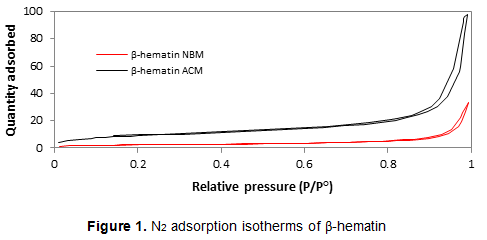Introduction: Malaria is an infectious blood disease caused by parasites of the Plasmodium genus. The parasite ingests hemoglobin and detoxifies heme into a crystalline pigment known as hemozoin. This pigment can be produced synthetically to understand the mechanism of action of antimalarials[1]. There are two widely accepted methods to obtain the synthetic analog of hemozoin (β-hematin), namely the anhydrous[2] and acidic-annealing method[1]. However, the materials produced present significant crystallographic differences, which represent a great challenge regarding data interpretation[3], and questions which method is more suitable to produce a material that mimics hemozoin. Additionally, the lack of knowledge about the surface properties of β-hematin hinders the understanding of its interactions with antimalarials[4]. In this work, we use a combination of spectroscopic and adsorption measures to characterize the surface properties of β-hematin synthesized by the aforementioned methods.
Materials and Methods: β-hematin crystals were produced by the anhydrous non-coordinated-base method (NBM)[2] and the aqueous acid-catalyzed method (ACM)[1]. Their surface area was measured through nitrogen adsorption/desorption isotherms using the Brunauer-Emett-Teller (BET) theory. The surface composition of both samples was characterized by X-ray photoelectron spectroscopy (XPS). Crystals produced by both methods were subjected to a chemical derivatization of –COOH groups by 2,2-trifluoroethanol (TFE)[5] for qualitative determination of their presence on the surface of the material using XPS.
Results and Discussion: BET analysis showed that β-hematin obtained with both methods display a type II isotherm (figure 1), typical of nonporous materials. For both methods, the experimental surface area was higher than the calculated. Additionally, the surface area of ACM crystals was around 26% higher than the produced by NBM (table 1).


XPS showed that both samples have a similar chemical composition and include adsorbed water molecules on their surface. Chemical derivatization with TFE (figure 3), showed that the surface of both samples presents -COOH groups, something previously unknown.

Conclusions: β-hematin crystals synthesized by the two methods showed similar surface properties, despite their crystallographic differences. The synthesis method should thus be selected based on the specific aim of the in-vitro experiment. For instance, ACM could be used to study interactions with antimalarials expected to act on the crystal surface, since these crystals showed higher surface area. However, NBM is more suitable to study antimalarials that aim to inhibit the growth mechanism. Finally, the identification of carboxylic groups on the surface of β-hematin may help to clarify the role of these species in mediating diverse phenomena, such as biomineralization and adsorption on surface.
Consejo Nacional de Ciencia y Tecnología CONACyT; Secretaría de Educación Pública SEP; McGill Excellence Doctoral Award
References:
[1] Slater, A., et al. (1991). "An iron-carboxylate bond links the heme units of malaria pigment." Proceedings of the National Academy of Sciences 88(2): 325-329.
[2] Bohle, D. S., et al. (2002). "Phase homogeneity and crystal morphology of the malaria pigment-hematin." Acta Crystallographica Section D: Biological Crystallography 58(10): 1752-1756.
[3] Egan, T. J. (2008). "Recent advances in understanding the mechanism of hemozoin (malaria pigment) formation." J Inorg Biochem 102(5-6): 1288-1299.
[4] Weissbuch, I. and L. Leiserowitz (2008). "Interplay between malaria, crystalline hemozoin formation, and antimalarial drug action and design." Chemical reviews 108(11): 4899-4914.
[5] Giglio, E.D., et al., Surface (XPS, SIMS) chemical investigation on poly (pyrrole‐3‐acetic acid) films electrosynthesized on Ti and TiAlV substrates for the development of new bioactive substrates. Surface and interface analysis, 2005. 37(6): p. 580-586.